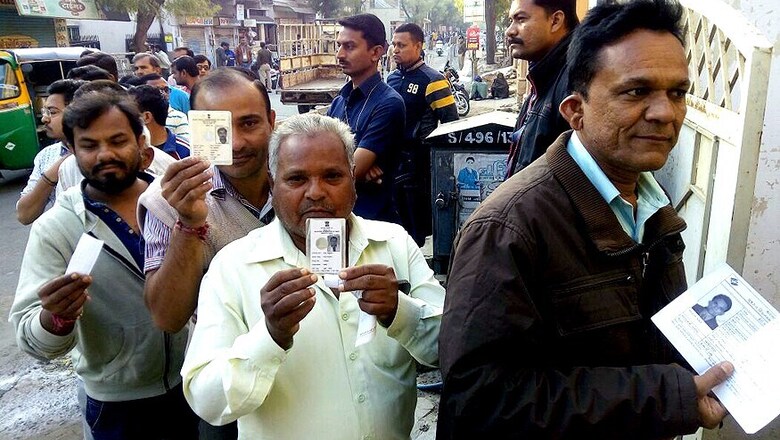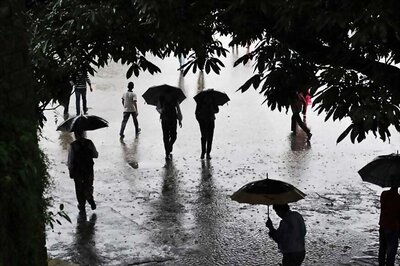
views
New Delhi: The Election Commission of India has announced the dates for the upcoming Lok Sabha polls. The elections will be held from April 11, 2019, in seven phases. This time Assembly polls in Andhra Pradesh, Arunachal Pradesh, Odisha and Sikkim will also be held simultaneously.
A News18 analysis of the Lok Sabha polls that were held since 1980 show that the political party, which emerged as single largest party, and formed the government at the Centre, has often replicated the performance in the respective state elections too.
News18 analyzed every Lok Sabha poll that has been held since 1980 and the respective simultaneous polls that were held in various states during the same time.
1980
In the seventh Lok Sabha elections in 1980, the Congress came back as the largest party by winning 353 seats followed by the Janata Party (Secular) with 41 seats. The vote share of both parties was 42.7 per cent and 9.4 per cent, respectively.
Simultaneously Assembly elections were held in four states — Arunachal Pradesh, Goa, Kerala and Manipur.
In 30-member Assembly elections of Arunachal Pradesh, INC (I) and PPP won 13-13 seats each with 42.6% and 41% votes. While the Congress won both seats of Lok Sabha from the state.
In Assembly elections of Goa, INC (U) bagged 20 seats (38.36 % votes) out of 30. Among the two parliament seats INC (U) and MAG (U) both won one seats each.
In 140-member Assembly elections of Kerala, CPM got 35 followed by INC (U), INC (I) and CPI got 21, 17 and 17 seats, respectively. In the Lok Sabha polls, the CPM got maximum 7 seats and INC (U) won 3 seats.
In 60-member Assembly elections of Manipur, INC (I) won 13 seats (21.6 per cent votes). Second and third largest parties were JNP with 10 seats (19.7 per cent votes) and INC (U) with 6 seats (9.5 per cent votes). Among the two parliament seats, INC (I) and CPI won one seats, each.
1984
In the eighth Lok Sabha elections in 1984, the Congress won 415 seats, largest number of seats ever with 48.1 per cent votes and successfully formed the government. Simultaneous Assembly elections were held in Arunachal Pradesh and Tamil Nadu that year.
In the 30-member Assembly of Arunachal Pradesh, the Congress won 21 seats with 43.1 per cent votes. The Congress also won the two Lok Sabha seats of the state.
In 234-member Assembly of Tamil Nadu, the ADMK became the largest party bagging 132 seats with 37 per cent of the vote share. The second largest party was Congress which won 61 seats (16.3 per cent votes). Among the 39 Lok Sabha seats of the state, Congress won 25 seats which was more than the 13 seats than the ADMK had won.
1989
In the ninth Lok Sabha elections in 1989, the Congress slipped to 197 seats by losing 218 seats it had earlier. The Janata Dal was the second largest party which won 143 seats. The BJP secured third position with 85 seats. Votes share of all three parties was 39.5 per cent, 17.8 per cent and 11.4 per cent, respectively.
Simultaneous Assembly elections were held in Andhra Pradesh, Sikkim, Goa, Nagaland and Uttar Pradesh.
In the 294-member Assembly of Andhra Padesh, the Congress, leaving behind the TDP bagged, 181 seats and 47.1 per cent votes. While the TDP won 74 seats with 36.5 per cent votes.
In the 32-member Assembly of Sikkim, SSP Swept all seats, bagging 70.4 per cent votes. The SSP also won the only one Lok Sabha seat too.
In the 40-member Assembly of Goa, Congress won half the seats i.e. 20, while MAG won 18. Vote share of both parties was 40.5 per cent and 38.8 per cent, respectively. Of the two Lok Sabha seats both parties won one each.
In the 60-member Assembly of Nagaland, the Congress won 36 seats (51.4 per cent votes) and NPC won 24 seats (41.6 per cent votes). The Congress won the only one seat of Lok Sabha from the state.
In 425-member Assembly of Uttar Pradesh, the Janata Dal was the largest party that got 208 seats with a 29.7 per cent vote share. The Congress, which got 27.9 per cent vote share, could only win 94 seats. The BJP was at third position with 57 seats with a vote share of 11.6 per cent.
1991
In the 10th Lok Sabha elections in 1991, leaving behind the Janata Dal, the Congress managed to win 244 seats with 36.4 per cent vote share. The BJP won 120 seats with a 20.1 per cent vote share. The Janata Dal came at third position with 59 seats with 11.7 per cent vote share.
Simultaneous Assembly elections were held in Assam, Haryana, Pondicherry (now Puducherry) and West Bengal that year.
In 122-member Assembly of Assam, the Congress was the largest party in the state too. It won 66 seats and the AGP won 19 seats. In 14 Lok Sabha seats, the Congress bagged 8 (28.5% votes) and the BJP 2 seats (9.6%). While the AGP which got 17.6% votes could win only one seat.
In 90-member Assembly of Haryana too, the Congress was the largest party by winning 51 seats. While the JP won 16. Among 10 Lok Sabha seats, the Congress bagged 9.
In 30-member Assembly of Pondicherry (now Puducherry), Congress won half the seats i.e 15 with 30% vote share. It also won Pondicherry (now Puducherry) — the only Lok Sabha.
In 294-member Assembly of West Bengal, the CPM won 189 seats with 36.9% votes. But the Congress could won just 43 seats despite having 35.1% votes. The CPM also won maximum seats (27) in the Lok Sabha from state.
1996
In the 11th Lok Sabha elections, the BJP got edge over the Congress. The Saffron party won 161 seats by securing 20.3% votes. While the rival Congress won 140 seats by securing 28.8% vote share which was higher than what the BJP got.
Simultaneous Assembly elections were held in Assam, Haryana, Kerala, Pondicherry (now Puducherry), Tamil Nadu and West Bengal.
In 122-member Assembly of Assam, AGP won 59 seats and 29.7% seats. But the Congress came at second position with a vote share of 30.6% and won 34 seats. While in the Lok Sabha results, both parties won 5 seats each.
In 90-member Assembly of Haryana, the HVP won 33 seats and the SAP 24 seats. But among the 10 Lok Sabha seats, the BJP won maximum 4 seats than others.
In 140-member Assembly of Kerala, CPM and Congress were at first two positions. Both parties won 40 and 37 seats. But in the Lok Sabha elections, the Congress got 7 but CPM won 5 seats of the total 20 seats.
In 30-member Assembly of Pondicherry (now Puducherry), the Congress bagged 9 seats and second to it, DMK won 7.
The Congress also won the one parliamentary constituency.
In 234-member Assembly of Tamil Nadu, DMK had 173 seats with 42.1% vote share. But in Parliamentary elections, TMC (M) won 20 seats i.e 3 seats more than the DMK which won 17.
In 294-member Assembly of West Bengal, the CPM bagged 157 and the Congress bagged 82 seats. Interestingly, there was not much difference in their vote share. CPM and Congress had 37.9% and 39.5% vote share. In the Lok Sabha polls, the CPM won 23 constituencies out of 42.
1998
In the 12th Lok Sabha elections, the BJP improved its performance by winning 182 seats on 25.6% vote share. The BJP under National Democratic Alliance (NDA) formed government at the Centre. The Congress got 141 seats with the increase of just one seats from its previous seats.
But government could not complete its full tenure and ended in October 1999 due to break up in the alliance.
The simultaneous Assembly elections were held in Gujarat, Meghalaya, Nagaland and Tripura.
In the 182-member Assembly of Gujarat, the BJP had won 117 seats with a vote share of 44.8 per cent. The Congress secured 34.8 per cent of vote share, winning 53 seats. The BJP also won more seats in the Lok Sabha. It won 19 and the Congress won 7.
In the 60-member Assembly of Meghalaya, the Congress won 25 seats while UDP 20. Congress won both the Lok Sabha seats of the state.
In the 60-member Assembly of Nagaland, the Congress won 53 seats. It also won the only single constituency of the state.
In 60-member Assembly of Tripura, CPM won majority with 38 seats. It also won both the Lok Sabha seats.
1999
In the 13th Lok Sabha elections in 1999, BJP retained its 182 seats. The Congress lost 27 seats and won 114 seats. The BJP again formed the government under NDA.
That year, the Assembly elections were simultaneously held in four states— Andhra Pradesh, Arunachal Pradesh, Karnataka and Maharashtra.
In the 294-member Assembly of Andhra Pradesh, the TDP won 180 seats ad the Congress 91. The TDP also won more seats in the Lok Sabha elections. Out of 42, the TDP bagged 29 seats.
In the 60-member Assembly of Arunachal Pradesh, the Congress bagged majority with 53 seats. It also won both the Lok Sabha seats of the state.
In the 224-member Assembly of Karnataka, the Congress had majority with 132 seats. The BJP won 44 seats. In the parliamentary constituencies too, the Congress got 18 seats, largest out of 28.
In 288-member Assembly of Maharashtra, the first three leading parties were Congress, SHS, and NCP with 75, 69 and 58 seats, respectively. But in the Lok Sabha, SHS won more seats than others. SHS won 15 while Congress won 10 out of a total of 48 seats.
2004
In the 14th Lok Sabha elections in 2004, the Congress got 145 seats followed by the BJP with 138 seats. The vote share of both parties was 26.5 and 22.2 per cent, respectively. The Congress-led United Progressive Alliance (UPA) government came to power at the Centre.
In 2004 LS polls, simultaneous Assembly elections were held in four states—Andhra Pradesh, Odisha, Karnataka and Sikkim.
In the 294-member Assembly of Andhra Pradesh, the Congress got majority with 185 seats, while the TDP won 47 seats. However, the vote share of both parties had not much difference. The Congress had 38.6 per cent while the TDP had 37.6 per cent vote share. The Congress won 29 of the total 42 Lok Sabha seats of the state.
In the 147-member Assembly of Odisha, the BJD won the majority with 61 seats. The Congress got 38 seats. The BJD also won largest Lok Sabha seats by bagging 11 of the 21 seats in the state.
In the 224-member Assembly of Karnataka, the BJP won 79 seats, followed by the Congress and the JD(S) which won 65 and 58 seats, respectively. The BJP also won the majority of the seats during the Lok Sabha polls in the state. The party won 18 out of the 28 Lok Sabha seats.
In the 32-member Assembly of Sikkim, the SDF swept the state with 31 seat with a 71.1 per cent vote share. It also won state’s only single constituency for the Lok Sabha.
2009
In the 15th Lok Sabha elections in 2009, the Congress got 206 seats followed by the BJP with 116 seats. The vote share of both the parties was 28.6 and 18.8 per cent, respectively. Congress-led UPA again came in power at the Centre.
In 2009, simultaneous Assembly elections were held in three states— Andhra Pradesh, Odisha, and Sikkim.
Though the Congress got success in forming government at the Centre but in all three states it came to power, Andhra Pradesh was the only state where it did better in the Lok Sabha elections.
Among the 42 Lok Sabha seats from the state, the Congress won 33. In 294-member Assembly elections, the Congress won 156 seats followed by the TDP with 92 seats. The vote share of both the parties was 36.6 per cent and 28.1 per cent, respectively.
In the 147-member Assembly elections of Odisha, the BJD won 103 seats with a 38.9 per cent vote share. The Congress was came second with 27 seats (29 per cent vote share). In the Lok Sabha elections too, BJD won 14 seats which were more than the double seats won by the Congress—it won just 6 seats.
In the 32-member Assembly elections of Sikkim, the SDF swept all the seats with a 65.9% vote share. The SDF also won the only Lok Sabha seat of the state.
2014
In the 16th Lok Sabha elections in 2014, the BJP got remarkable victory over the rival Congress and emerged as the single largest party winning 282 seats with a 31.3 per cent vote share. The Congress which was earlier at the Centre with the UPA could only manage to win just 44 seats. The Congress’s vote share was a paltry 19.5 per cent.
During 2014, general elections simultaneous assembly elections were held in Andhra Pradesh, Arunachal Pradesh, Odisha and Sikkim. Though the BJP got success in forming government at the Centre but in these Assembly elections it did not fare well.
In Andhra Pradesh elections, Telugu Desam Party (TDP) emerged as the key player by defeating previously ruling Congress and bagged 102 seats to form the government. The BJP got only 4 seats. Initially, the BJP was in the alliance with the TDP but it got spilt in March 2018.
After the bifurcation of Andhra Pradesh and the formation of Telangana in 2014, the state was allocated 175 seats and the remaining 119 seats were allocated to the latter in their respective assemblies.
In Arunachal Pradesh Assembly elections, the Congress defeated the BJP. The Congress won 42 seats with a 50 per cent vote share, while the BJP got 11 seats with 31.3 per cent vote share. However, both the parties won one parliamentary seat each from the state.
In Odisha Assembly elections, the Biju Janata Dal (BJD) won the majority with 117 seats. The BJD secured 43.9 per cent vote share. The Congress and the BJP got 16 (26 per cent vote share) and 10 seats (18.2 per cent vote share) respectively. In the Lok Sabha elections too, the BJD won 20 seats of total 21 while the BJP won just one.




















Comments
0 comment